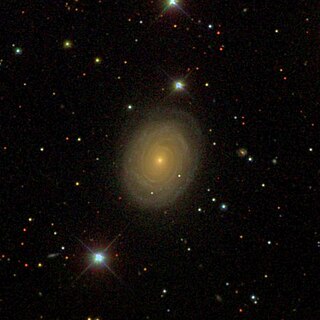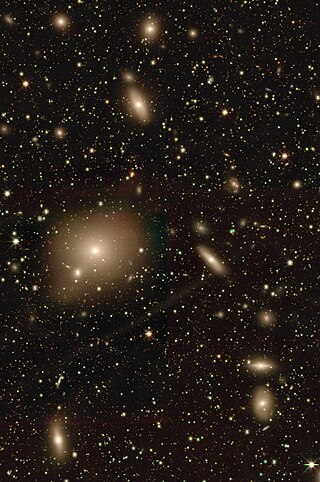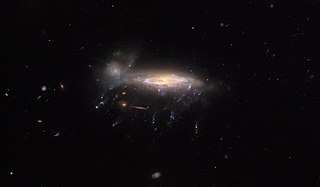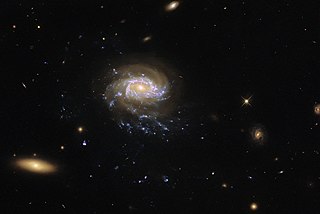
NGC 7001 is an intermediate spiral galaxy located about 300 million light-years away in the constellation Aquarius. NGC 7001 has an estimated diameter of 123,000 light-years. It was discovered by English astronomer John Herschel on July 21, 1827, and was also observed by Austrian astronomer Rudolf Spitaler on September 26, 1891.

UGC 6614 is a giant spiral galaxy located about 330 million light-years away in the constellation Leo. It has an estimated diameter of nearly 300,000 light-years.

NGC 4596 is a barred lenticular galaxy located about 55 million light-years away in the constellation Virgo. NGC 4596 was discovered by astronomer William Herschel on March 15, 1784. NGC 4596 is a member of the Virgo Cluster and has an inclination of about 38°.

NGC 4709 is an elliptical galaxy located in the constellation Centaurus. It is considered to be a member of the Centaurus Cluster and is the dominant member of a small group of galaxies known as "Cen 45" which is currently merging with the main Centaurus Cluster even though the two subclusters' line of sight redshift velocities differ by about 1500 km/s. NGC 4709 was discovered by astronomer James Dunlop on May 7, 1826.
Red nuggets is the nickname given to rare, unusually small galaxies packed with large amounts of red stars that were originally observed by the Hubble Space Telescope in 2005. They are ancient remnants of the first massive galaxies. The environments of red nuggets are usually consistent with the general elliptical galaxy population. Most red nuggets have merged with other galaxies, but some managed to stay unscathed.

NGC 3860 is a spiral galaxy located about 340 million light-years away in the constellation Leo. NGC 3860 was discovered by astronomer William Herschel on April 27, 1785. The galaxy is a member of the Leo Cluster and is a low-luminosity AGN (LLAGN). Gavazzi et al. however classified NGC 3860 as a strong AGN which may have been triggered by a supermassive black hole in the center of the galaxy.

NGC 4299 is a featureless spiral galaxy located about 55 million light-years away in the constellation Virgo. It was discovered by astronomer William Herschel on March 15, 1784 and is a member of the Virgo Cluster.

NGC 4313 is an edge-on spiral galaxy located about 50 million light-years away in the constellation Virgo. It was discovered by astronomer William Herschel on March 15, 1784. NGC 4313 is a member of the Virgo Cluster and is classified as LINER and as a Seyfert galaxy.

NGC 4324 is a lenticular galaxy located about 85 million light-years away in the constellation Virgo. It was discovered by astronomer Heinrich d'Arrest on March 4, 1862. NGC 4324 has a stellar mass of 5.62 × 1010M☉, and a baryonic mass of 5.88 × 1010M☉. The galaxy's total mass is around 5.25 × 1011M☉. NGC 4324 is notable for having a ring of star formation surrounding its nucleus. It was considered a member of the Virgo II Groups until 1999, when its distance was recalculated and it was placed in the Virgo W Group.

NGC 4393 is a spiral galaxy about 46 million light-years away in the constellation Coma Berenices. It was discovered by astronomer William Herschel on April 11, 1785. It is a member of the NGC 4274 Group, which is part of the Coma I Group or Cloud.

NGC 5953 is a peculiar spiral galaxy in the constellation Serpens. The galaxy lies about 80 million light years away from Earth, which means, given its apparent dimensions, that NGC 5953 is approximately 35,000 light years across. It was discovered by William Herschel on April 17, 1784. NGC 5953 interacts with NGC 5954 forming a pair known as Arp 91.

NGC 3448 is an irregular galaxy in the constellation Ursa Major. The galaxy lies about 75 million light years away from Earth, which means, given its apparent dimensions, that NGC 3448 is approximately 125,000 light years across. It was discovered by William Herschel on April 17, 1789.

LEDA 1245565, is a spiral galaxy located 1.04 billion light-years away in the constellation of Virgo. It has a similar structure as the Milky Way though it has a low black hole mass. It has an active galactic nucleus and is classified as a narrow-line Seyfert 1 galaxy with enhanced star formations.

PGC 29820 is a spiral galaxy located 600 million light-years away from the Solar System in the Sextans constellation. The galaxy is about 120,000 light-years in diameter and is a member of Abell 957, a low-mass galaxy cluster. The first known reference to this galaxy is from volume I of the Catalogue of Galaxies and of Clusters of Galaxies compiled by Fritz Zwicky in 1961, where it was listed as CGCG 008-077.

PGC 65543, is a spiral galaxy, with extensive star forming regions, located in Indus. It is 650 million light-years away from the Solar System and approximately measuring 90,000 light-years in diameter. The tidal interactions from certain galaxies which PGC 65543 is moving towards to, have caused it to get distorted. Its star-forming gas and dust are dynamically stripped by ram-pressure and formed into tendrils that stretch outwards, thus gives an appearance of a jellyfish galaxy.

UGC 934, known as PGC 5085, is a large spiral galaxy about 470 million light-years away from the solar system. It is located in the constellation of Pisces and about 285,000 thousand light-years in diameter.

PGC 2456 known as KAZ 364 and JO201, is a spiral galaxy located in the constellation of Cetus. It is located 617 million light-years away from the Solar System. A member of Abell 85, PGC 2456 lies 360 kiloparsecs from the brightest cluster galaxy, Holmberg 15A.

UGC 711 is a relatively nearby spiral galaxy located in the constellation of Cetus. Estimated to be located 77 million light-years from Earth, the galaxy's luminosity class is IV and it has a HI line width region. It belongs to the equatorial region of Eridanus Void with an arcsec approximation of ≈ 250.

















